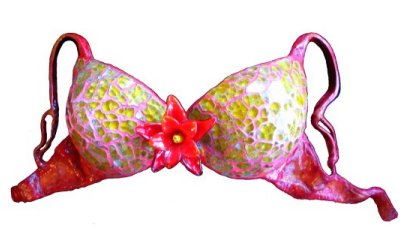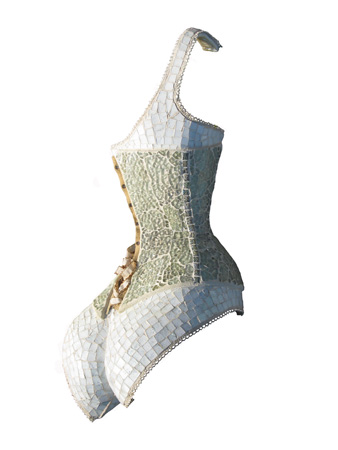
Laura Ann Jacobs has produced a "body" of glittering, brilliant, and campy art in a manner(ism) I would describe as ineluctably refreshing. Her enticing vestiges suggest a meeting point between sensory and sensational experience, a carnival arabesque full of masquerade and charade, a clamoring, precisely rendered group of lingerie brocades impossible to resist. Admittedly, I was taken by surprise -- pleasurably off-guard, in fact -- upon first encountering her work. While perusing these rapturous, coy, and ironic garments, I further discovered that Jacobs enjoys playing with language. Her titles are based on puns that give a humorous edge to the work. For example A Conch-scious She Sell Expecting is an actual-size female torso made of tempered glass inlay over painted resin in which two actual conch shells function metaphorically as two delectably ascending nipples. The visual and literary inflexions imply a connection with artists such as Marcel Duchamp or perhaps the famous Dada bon vivant and assemblage artist -- in fact a contemporary of Duchamp in the early 1920s, and part of the famous Arensberg circle in Manhattan -- namely, the Baroness Elsa van Frietag Loringhoven. Whatever historical connections are made, Laura Ann Jacobs lives and works as an artist very much in the present tense. "Laura's Aura" -- as she once penned her art -- flourishes with energy and provocation, very much in line with the New York Dadas of the 1920s. She would have matched beautifully with Beatrice Wood and Florine Stettheimer, two of the other great artist-flappers of the Dada era, persistently bent on breaking the codes in their generation.
Having recently re-read Clement Greenberg's profound essay, "Avant-garde and Kitsch," in which the critic sets up an opposition between two cultural tendencies in the twentieth century -- advanced art and popular culture -- I am struck by the way Jacobs' work seems to function on both levels simultaneously. Through her lightness and irony -- in contrast to the uptight cynicism so often found among Post-Pop artists today -- she has managed to bring kitsch into the foreground of serious art. By this I mean that she represents not only a sentimental side of culture, but appropriates chic garmentry, such as stiff corsets and tightly buttoned shoes, from the Victorian age, seen in The Breast of Both Whorls I and II and Davenatrix, and then reinvents their meaning through her personal touch. The delights to be found in these resin and tempered glass works employ various found objects, which include idiosyncratic material, associated with forms of sexual play, such as leather, rivets, and spiked shoes. These appear in the context of other curious objects, such as Swarovski crystal, silverware, jade beads -- all syntactically transformed into decorative fetishes as if to satisfy our fantastic fixations. Could it be that Jacobs' ingeniously subversive corsets and brassieres are lifting the lid from lingering Victorian repressions of another era and are placing them squarely within the Postmodern age?
I would argue that whether or not her work is Postmodern is less important than the fact that it belongs in the rambunctious world of the present where ideological oppositions, whether aesthetic or political, are suspended without resolution. The human impulse may attempt to impose a resolution, but it rarely, if ever works. This is the wisdom I see in Jacobs' work. Her objects transform into fetishes not by force but through a process of mental relaxation. To really sense what her shoes, boots, bras, and corsets are doing is not only visual but part of our imaginative potential as human beings. One might say that the artist's work is less a representation than a bold presentation. Full Bloom uses a technique familiar to the artist: tempered glass over resin with blown glass. The finale, so to speak, is the red plastic flower. One might call it a metaphor, but it feels stronger than that. Somehow this powerfully expressive bra with its bright red flower positioned between the two cups appears as a life-living, erotically charged work of art. It does not represent anything, in particular. Rather it presents what it is.
 One of my personal favorites in the exhibition is called Turn the Other Cheek, a cut-glass mosaic with tempered glass inlay, lace, leather, rivets, and alluring ribbons. Instead of the cheeks of the face, we voyeuristically observe a woman's buttocks -- the nemesis of Victoriana, but also, for some, an erotic delight. In the 1890s, the cheeks, as it were, were hidden beneath a swath of petticoats, often with a bustle intended to further disguise the appearance of the actual derriere. In Jacobs' finely wrought simulation, the cheeks are bare and behind them on the "underside" one discovers the text of a medieval German bible -- the perfect sign of authoritarian repression. Here the conflict between pedantic religion and expulsive sex are placed in opposition to one another. There is no resolution other than the throbbing desire that links the two extremes.
One of my personal favorites in the exhibition is called Turn the Other Cheek, a cut-glass mosaic with tempered glass inlay, lace, leather, rivets, and alluring ribbons. Instead of the cheeks of the face, we voyeuristically observe a woman's buttocks -- the nemesis of Victoriana, but also, for some, an erotic delight. In the 1890s, the cheeks, as it were, were hidden beneath a swath of petticoats, often with a bustle intended to further disguise the appearance of the actual derriere. In Jacobs' finely wrought simulation, the cheeks are bare and behind them on the "underside" one discovers the text of a medieval German bible -- the perfect sign of authoritarian repression. Here the conflict between pedantic religion and expulsive sex are placed in opposition to one another. There is no resolution other than the throbbing desire that links the two extremes.
Laura Ann Jacobs is a serious artist who gives her work intelligence on all levels -- form, technique, and content. To this, she adds a dose of humor and a quality of lightness that allows us to open the doors of repression and laugh, shout or moan, whatever or however we choose to respond. Her work impresses me as truly feminine to the extent that its message exists on the level of an understated radicality. Best of all, it is work that can be enjoyed by all genders and persuasions, regardless of race or creed, simply because it engages us to think and to feel, and to open our minds and our hearts a little wider.
_______________________________________________________________________